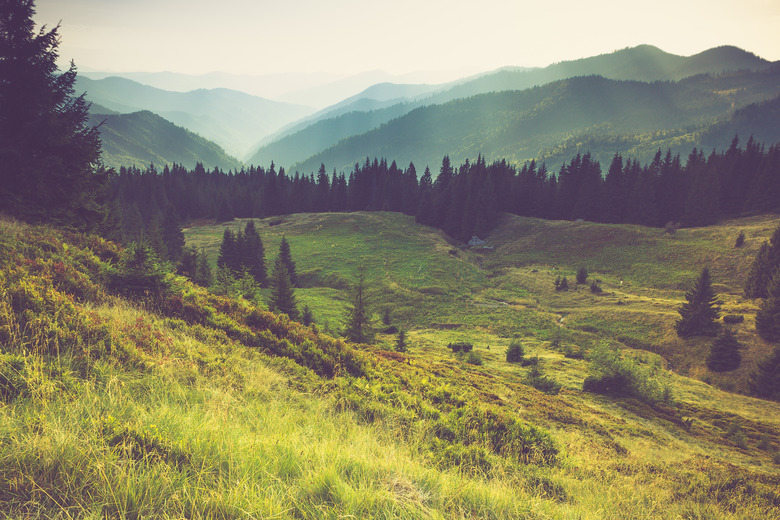Differences Between North- And South-Facing Slopes
The face a slope presents to the sun – north or south – plays a role in the local climate created on it. This "microclimate" helps determine the types of plants that colonize the slope and influences which animals are drawn to the area seeking their preferred foods and suitable shelter. The basic difference between north- and south-facing slopes – the relative amount and intensity of sunlight they receive – leads to profound ecological differences, similar (but reversed) in the Northern and Southern Hemisphere.
Amount of Sunlight
Amount of Sunlight
In the Northern Hemisphere, north-facing slopes in latitudes from about 30 to 55 degrees receive less direct sunlight than south-facing slopes. The lack of direct sunlight throughout the day, whether in winter or summer, results in north-facing slopes being cooler than south-facing slopes. During winter months, portions of north-facing slopes may remain shaded throughout the day due to the low angle of the sun. This causes snow on north-facing slopes to melt slower than on south-facing ones. The scenario is just the opposite for slopes in the Southern Hemisphere, where north-facing slopes receive more sunlight and are consequently warmer. Near the equator, north- and south-facing slopes receive roughly the same amount of sunlight because the sun is almost directly overhead. At the poles, north and south slopes tend to be either shrouded in darkness all winter long, or bathed in sunlight all summer long, with only slight variation between the slopes in spring and fall.
Depth of Soil
Depth of Soil
Depth of soil on a slope, whether it faces north or south, depends on the steepness of the slope. The steeper the incline, the higher the rate of soil erosion from rain runoff. Soils on steep slopes are primarily made up of rock fragments because pieces of lightweight organic matter, such as leaves, wash away before they can decompose into soil. Slopes that have a gentle incline tend to accumulate a deeper layer of soil. In the Northern Hemisphere, soil on south-facing slopes dries out faster and is warmer than soil on north-facing slopes due to longer exposure to sunlight – the opposite applies in the Southern Hemisphere.
Effect of Rainfall
Effect of Rainfall
The amount of rain that falls on a slope and is taken up by existing vegetation is determined by how steep the slope is, rather than whether it faces north or south. Rain runs more quickly off steeper slopes and does not have time to be taken up by plants. Rain falling on less steep inclines stays in the soil longer and is utilized by plants and trees, generally resulting in larger plants and/or colonization of plants with higher hydration needs. Slope aspect can figure into this, however: Vegetation on south-facing slopes in the Northern Hemisphere, for example, has less time to take up water because of the drying effect of the sun.
Effect on Plant Communities
Effect on Plant Communities
Given the effects of varying solar insolation, plant communities can vary widely between north- and south-facing slopes. In the Northern Hemisphere, warmer south-facing slopes green up sooner in spring, stay greener longer in the fall and tend to be drier than north-facing slopes. Plants that tolerate these hot, dry conditions – which, depending on the region, may be oaks, pines or drought-tolerant shrubs and grasses –grow well on southern slopes in their native range. A few feet away, a cooler, moister north-facing slope with a gradual incline may be dotted with closed mixed-hardwood or conifer forest and shade-tolerant wildflowers. Trees capture indirect sunlight better than low-growing grasses.
Cite This Article
MLA
Williams, Diana K.. "Differences Between North- And South-Facing Slopes" sciencing.com, https://www.sciencing.com/differences-between-north-southfacing-slopes-8568075/. 27 April 2018.
APA
Williams, Diana K.. (2018, April 27). Differences Between North- And South-Facing Slopes. sciencing.com. Retrieved from https://www.sciencing.com/differences-between-north-southfacing-slopes-8568075/
Chicago
Williams, Diana K.. Differences Between North- And South-Facing Slopes last modified March 24, 2022. https://www.sciencing.com/differences-between-north-southfacing-slopes-8568075/
